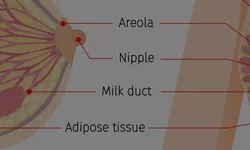Breast milk can come in many different colors: brown, green or even blue! Our guideline of breast milk colors explain what they each mean and when to be worried.
Besides the normal white, one color is more common than others: yellow! Yellow breast milk can mean many things and that's why we've decided to write a dedicated article about it.
Jump directly to the most likely possibility in your case by clicking on the corresponding link below or just read on to go through all possibilities.
- Your milk is yellow because it's still colostrum
- Your milk is yellow because it's transitional milk (between colostrum and mature)
- Your milk is yellow because you or your baby are sick
- Your milk is yellow because of your diet
- Your milk is yellow because it's high in fat
Your milk is yellow because it's still colostrum
Colostrum, the very first milk you express after giving birth, has a characteristic yellow-orange color. That's because it's full of β-Carotenes (pronounce "beta-carotenes"), the same pigment that's abundant in carrots.
β-Carotenes contribute to the vitamin A needs of your baby1 and exert important functions in immunity, in the antioxidant defense system, and are related to a reduced risk of developing chronic diseases.2

Colostrum (left) versus mature milk (right)
Another reason for colostrum's yellow color is because it's full of white blood cells and antibodies. Somewhat counterintuitively, when your breast milk has a high concentration of white blood cells, it tends to take on a yellow color.
Often referred to as a baby's "first vaccine", colostrum gives a fantastic kick-start to your baby’s undeveloped immune system. In fact between 13% and 70% of colostrum's total cells are white blood cells, the cells of the immune system designed to protect the body against invasions3. On top of that it's packed with antibodies such as immunoglobulins and lactoferrins.
Colostrum lasts from anywhere between 2 and 5 days. Your milk then becomes "transitional milk" before becoming mature.
Your milk is yellow because it's transitional milk (between colostrum and mature)
Transitional milk is the milk that immediately follows colostrum.
It has lost the orange tint of colostrum but it remains positively yellow.

Transitional milk (right)
Transitional milk starts immediately after colostrum ends and lasts for about 10 days, at which point it becomes mature milk. Of course every mother is unique, some will get mature milk much earlier or much later. You'll know by the change in color (from yellow to white) and the increased milk volume.
A key feature of the transition from colostrum to transitional milk and finally to mature milk is the large increase in milk supply.
From 1 to 2 oz (30 to 60 ml) per feeding, by the time your milk is mature your supply should have increased to about 3.5 oz (100 ml) per feeding. See our feeding guide by age for more details.
Many women struggle to increase their milk supply. If that's your case we highly recommend you use Milk Boost Tea. It's an ancestral recipe of 13 natural herbs that works wonders to boost your milk volume and its nutritional value.
Among its ingredients is Dong Quai, a root also known as the "female ginseng" for its wide range of health benefits for women. It also contains Sponge gourds (Loofah), famous for their ability to facilitate lactation.

Milk Boost Tea is a natural herbal tea that can help you improve your milk volume and its nutritional value
Your milk is yellow because you or your baby are sick
Contrary to formula, your breast milk is smart!
When you breastfeed you constantly receive information from your baby's immune system. It informs you about which attacks from bacteria or viruses it faces. And you reply by filling your breast milk with the necessary white blood cells and antibodies.
If you are sick yourself or your body is under attack from a virus or bacteria, the same thing happens. Your immune system comes to the logical conclusion that your baby might face the same attack and fills your breast milk with the appropriates defenses.

Normal milk (left) vs milk when you or your baby is sick (right)
Scientists have found instances when, if the mother or the baby are fighting a bacterial or viral attack, white blood cells numbers can increase up to 94% out of total cells in breast milk3!
This is a key reason why it's so important to breastfeed, you help keep your little one healthy and safe!
Your milk is yellow because of your diet
Your breast milk is largely composed of what you eat. It therefore stands to reason that if you eat food that contain a lot of beta-carotenes, a yellow-orange pigment famous for giving its color to carrots, some of it will tint your milk.

If you eat food that contains a lot of beta-carotenes, like carrots, your milk might become yellow
Besides carrots, foods that contain a lot of beta-carotenes include pretty much all the vegetables that take a yellow-orange color. That includes sweet potatoes, squashes, pumpkins, some types of yams, etc.
Some supplements or drugs might also affect the color of your milk, particularly if they themselves contain beta-carotenes.
Seeing your breast milk turn yellow due to your diet is nothing to worry about. In fact beta-carotenes are good for your little one because it contributes to their vitamin A needs1. Normally the color will revert to white again as you change your diet.
Your milk is yellow because it's high in fat
High fat content in breast milk can make the color seem slightly yellow. The color is more obvious if the milk is in the fridge or freezer.
Fat accounts for 4.4% of breast milk on average but around 60% of its calories. To know more, read our article about fat in breast milk breast milk.

Hindmilk (right) has a much higher fat content than foremilk (left)
Your milk is high in fat because it's hindmilk
The fat content of your breast milk can rise substantially depending on whether it is hindmilk or foremilk. We refer to the milk at the beginning of a breastfeeding/pumping session as "foremilk": it tends to be thinner in texture and often has a grey/bluish hue. As the feeding goes on, your milk progressively becomes "hindmilk": it becomes ticker, creamer and has a more yellowish tone. This is because it has much more fat/lipids in it than foremilk.
This particularly happens to women who breastfeed their baby and then pump out what's left for storage. The milk they pump out tends to be hindmilk with a much higher fat content and therefore a more yellowish tone.
Your milk is high in fat because of your diet
Some women also simply produce milk that has a higher fat content than average. Milk averages 21 kcal per ounce but it can go up to 35 kcal per ounce. Since 60% of breast milk's calories are fat, this means some mothers produce milk that has a much higher fat content than average.
It is not necessarily a bad thing if your baby's weight curve is normal. However, if your baby becomes overweight, it might be good idea to adapt your diet so as to produce a milk with a lower fat content. To do so, you can eat less fatty foods or eat foods with higher quality fats such as fatty fishes (mackerel, salmon, herring, sardines, etc.) or plants such as walnuts, flax seeds, chia seeds, etc. To know more, read our article about fat in breast milk breast milk.
Milk that's high in fat increases risk of developing clogged ducts
Women who produce milk with more fat content than average are more at risk to develop engorgement, clogged ducts or, in the worse cases, mastitis.
If that's your case we highly recommend you drink Unblock Nursing Tea. It's an herbal tea made of 12 natural herbs that's designed to help fight off engorged breasts and clogged ducts.
It contains ingredients such a Honeysuckle flowers, famous for their anti-inflammatory properties or Angelica roots, which are known to reduce lumps and swellings.

Unblock Nursing Tea is recommended to prevent clogged ducts and engorged breasts
Sources:
1. Stoltzfus R.J., Hakima M., Miller K.W., Rasmussen K.M., Dawiesah S.I., Habicht J.P., Dibley M.J. High dose vitamin A supplementation of breast-feeding Indonesian mothers: Effects on the vitamin A status of mother and infant. J. Nutr. 1993;123:666–675. doi: 10.1093/jn/123.4.666.
2. Bendich A. Non-provitamin A activity of carotenoids: Immunoenhancement. Trends Food Sci. Tech. 1991;2:127–130. doi: 10.1016/0924-2244(91)90648-3.
3. Hassiotou F, Hepworth AR, Metzger P, et al. Maternal and infant infections stimulate a rapid leukocyte response in breastmilk. Clin Transl Immunology. 2013;2(4):e3. Published 2013 Apr 12. doi:10.1038/cti.2013.1
Article tags: Breastfeeding and maternity








